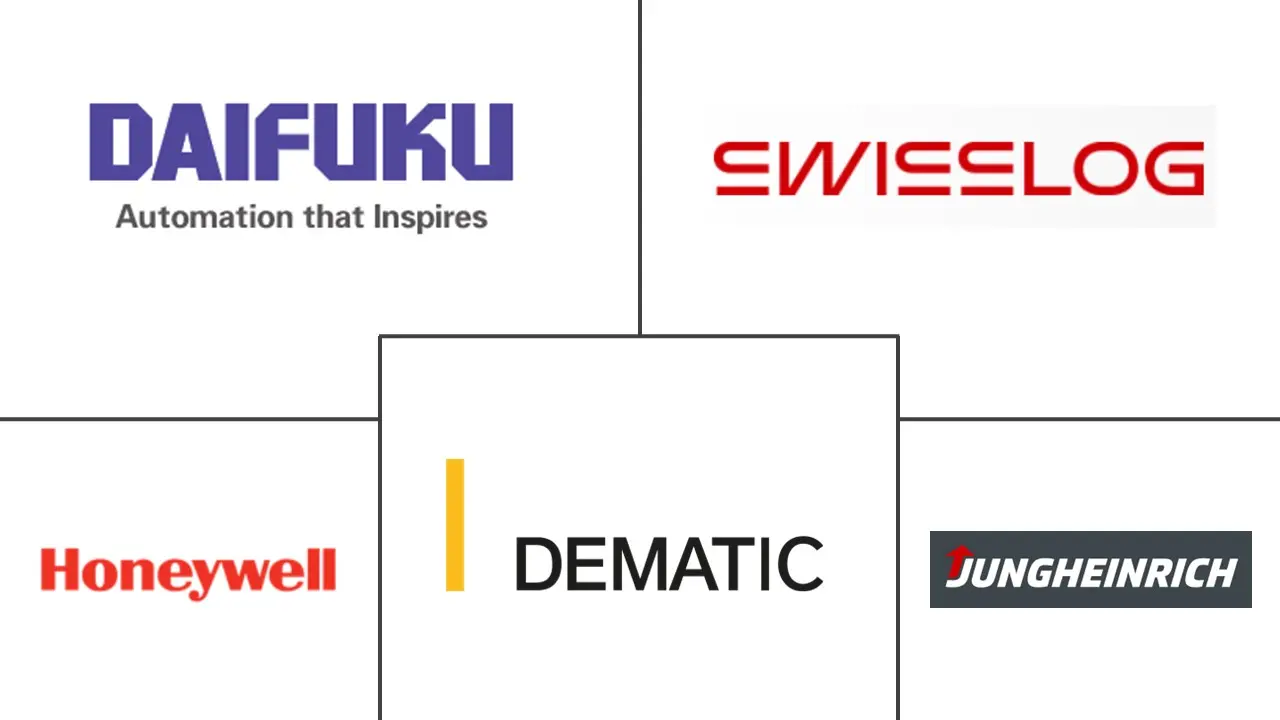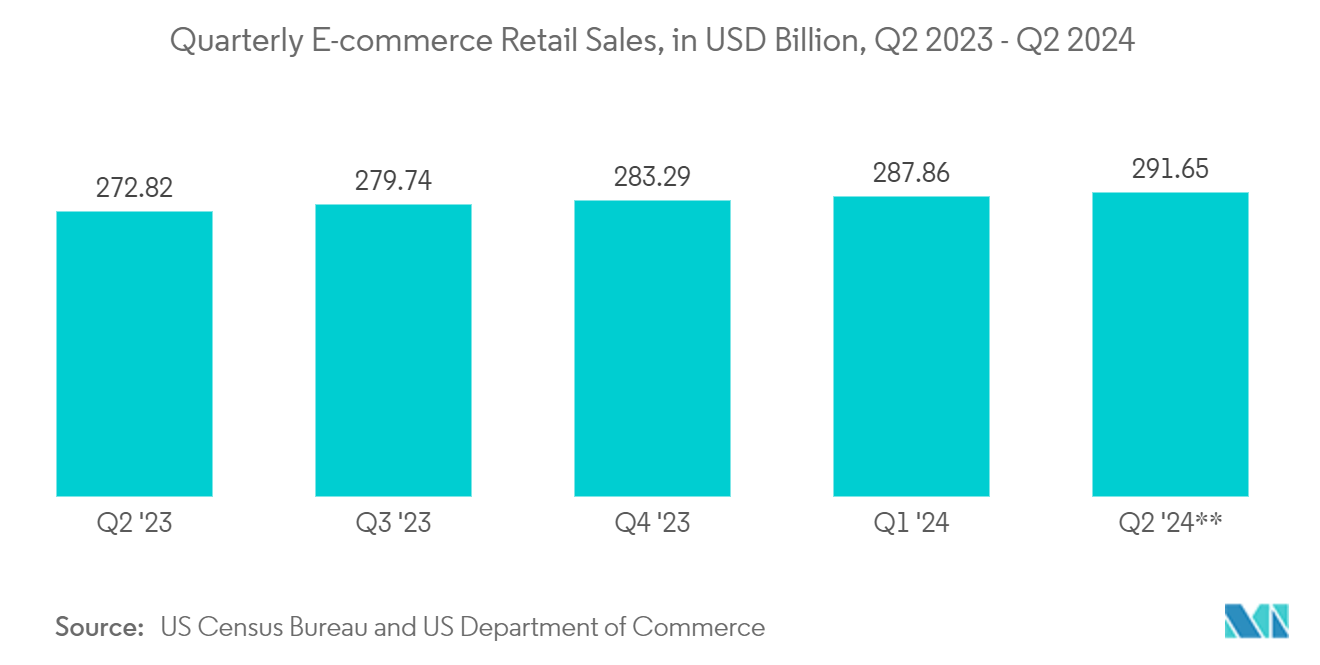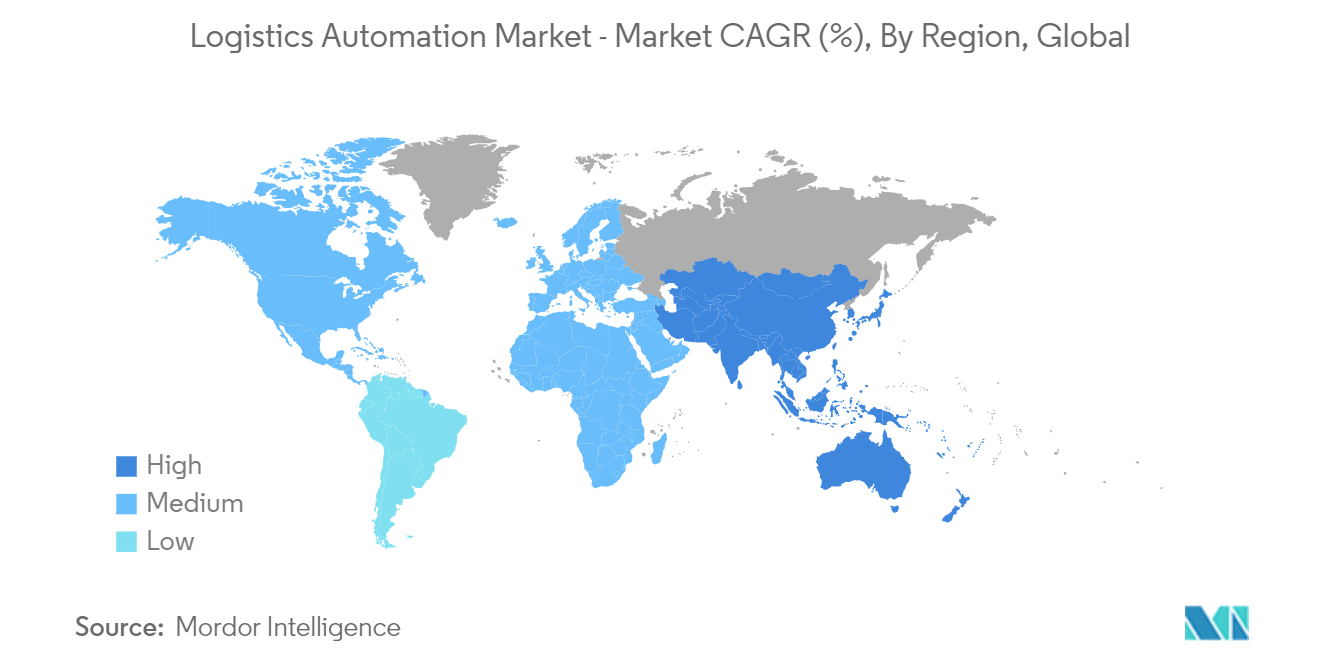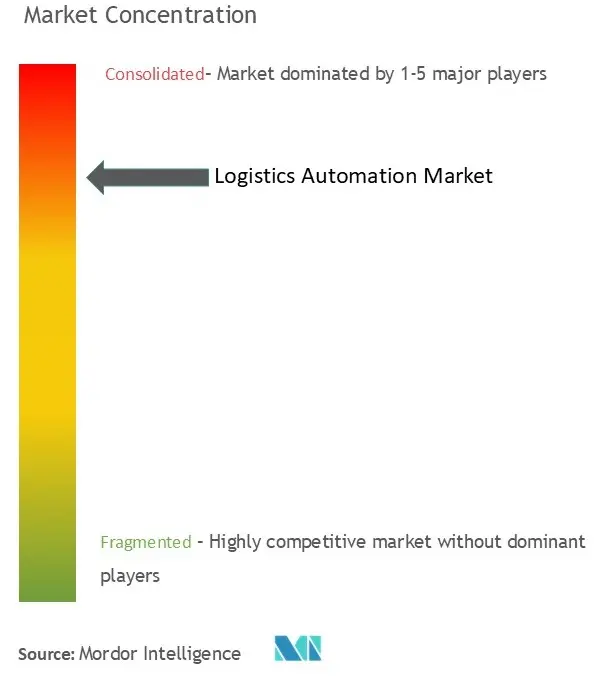Logistics Automation Market Size

| Study Period | 2019 - 2029 |
| Market Size (2024) | USD 75.24 Billion |
| Market Size (2029) | USD 120.63 Billion |
| CAGR (2024 - 2029) | 9.90 % |
| Fastest Growing Market | Asia Pacific |
| Largest Market | Asia Pacific |
Major Players
*Disclaimer: Major Players sorted in no particular order |
Logistics Automation Market Analysis
The Logistics Automation Market size is estimated at USD 75.24 billion in 2024, and is expected to reach USD 120.63 billion by 2029, growing at a CAGR of 9.90% during the forecast period (2024-2029).
- Manufacturing Complexity Fueling Automation Adoption: The growing complexity in manufacturing processes is accelerating the adoption of logistics automation systems. Warehouse sizes have expanded dramatically, with average warehouse space tripling from 65,000 sq. ft. in 2000 to over 200,000 sq. ft. This scale-up has led to a significant demand for warehouse automation technology, as it becomes increasingly challenging to manage higher volumes and an ever-growing variety of SKUs. To address these issues, companies are turning to advanced solutions like automated material handling systems and autonomous mobile robots (AMRs). A prime example is the 266% productivity increase achieved by Integrated Supply Network after deploying 49 AMRs from Körber and Locus Robotics, with picking efficiency skyrocketing from 30 to 110 picks per hour.
- Workforce Safety and Efficiency Improvements: The introduction of automation technologies is substantially enhancing workforce safety and operational efficiency in logistics environments. According to the U.S. Bureau of Labor Statistics, over 15,000 work-related incidents are reported annually in storage and warehousing, highlighting the industry's safety risks. Logistics automation systems, including light-guided docking solutions and automated storage and retrieval systems (ASRS), help mitigate these hazards. Additionally, automated systems eliminate human error and operate 24/7, ensuring higher productivity without the need for breaks or shift changes.
- Technological Advancements Reshaping Logistics: The integration of cutting-edge technologies such as IoT, artificial intelligence (AI), and machine learning into logistics automation is revolutionizing the industry. These advancements facilitate real-time data processing, smart warehousing, and enhanced decision-making. For instance, Amazon’s deployment of over 200,000 mobile robots underscores the transformative power of robotics in logistics, optimizing everything from supply chain automation to fleet management. The growing use of warehouse execution systems, powered by AI, is improving service levels, reducing operational bottlenecks, and elevating overall efficiency.
- Competitive Landscape and Investment Trends: The logistics automation market is relatively fragmented, with industry leaders like Kion Group, Daifuku, and Honeywell driving market growth through consistent innovation and strategic investments. These companies focus on enhancing their portfolios with advanced robotics in logistics and automated guided vehicles (AGVs). A notable development is the March 2023 launch of Digit, a versatile logistics robot by Agility Robotics, which is set to revolutionize bulk material handling. Furthermore, the market is witnessing robust investments in AI-powered logistics automation trends, as seen with UK-based BotsAndUs raising EUR 12.3 million (USD 13.75 million) in 2022 to enhance warehouse automation.
- Future Outlook and Opportunities: The logistics automation industry outlook suggests significant future growth driven by the proliferation of autonomous systems embedded with sensors, AI, and data analytics. Robotics-as-a-Service (RaaS) is emerging as a game-changer, enabling broader adoption of automated logistics systems by reducing upfront costs and offering scalability. Automated guided vehicles (AGVs) and autonomous mobile robots (AMRs) are expected to dominate the logistics automation landscape, with increasing use in both consumer and industrial sectors. Companies that successfully integrate advanced automation technologies and adapt to evolving market demands will secure leadership in this expanding market.
Logistics Automation Market Trends
Warehouse Automation Dominating the Market Landscape
Warehouse Automation: Dominating the Market Landscape
- Leading market share: Warehouse automation technology accounts for a significant portion of the logistics automation market, holding a dominant 41.58% market share in 2022. This segment, valued at USD 26.31 billion in 2022, is forecast to grow at a CAGR of 10.01%, reaching USD 45.92 billion by 2028. The demand is being driven by rapid e-commerce expansion and the need for smart fulfillment centers that incorporate automation.
- Technological advancements driving efficiency: Innovations such as automated material handling systems and AI-driven analytics are significantly enhancing warehouse automation processes. The use of advanced robotics, sensors, and IoT in logistics is enabling real-time inventory tracking, reducing human intervention, and streamlining operations across the supply chain. The integration of AI-powered logistics automation software is a crucial factor in improving overall warehouse efficiency.
- E-commerce boom propelling market growth: The e-commerce surge is a primary driver behind the growing demand for automated warehousing. U.S. retail e-commerce sales reached USD 261.97 billion in Q4 2022, emphasizing the need for logistics automation to support higher order volumes. E-commerce giants are prioritizing investments in smart warehousing solutions to handle this growth effectively.
- Rising number of warehouses boosting demand: The increasing number of warehousing facilities worldwide is contributing to the growth of the logistics automation market. The U.S. alone saw warehousing enterprises grow from 16,992 in 2016 to 20,002 in 2021, reflecting a greater reliance on automated logistics systems to manage complex supply chains.
- Emerging business models: Robotics-as-a-Service (RaaS) is gaining traction in the market, offering affordable and scalable automation solutions. By providing access to cutting-edge technology without the financial burden of full ownership, RaaS lowers barriers to entry for companies in sectors such as retail, e-commerce, and third-party logistics.
Transportation Automation: The Fast-Growing Segment
- High-growth potential: While warehouse automation commands the largest share, transportation automation is the fastest-growing segment in the logistics automation industry. This sector is projected to achieve a CAGR of 10.77%, driven by advancements in autonomous delivery systems, smart transportation management systems (TMS), and AI-driven logistics solutions. The increasing deployment of autonomous vehicles is reshaping the transportation aspect of logistics operations.

Asia-Pacific: The Growth Engine of Logistics Automation
- Leading the market: The Asia-Pacific region dominates the global logistics automation market with a 47.16% share in 2022. This region is forecast to maintain its leadership, growing to USD 22.84 billion by 2028, driven by a robust CAGR of 10.99%. The demand for logistics automation systems is fueled by the expansion of e-commerce and manufacturing in key markets such as China, Japan, and Australia.
- E-commerce and manufacturing driving regional growth: Rapid industrialization and e-commerce adoption across Asia-Pacific countries are significant contributors to the growth of logistics automation trends in the region. For example, Australia's thriving e-commerce sector, ranked eleventh globally, is forecast to generate USD 32.3 billion in revenue by 2024.
- Strategic investments and expansions: Key players in the logistics automation market are investing heavily in the Asia-Pacific region. In December 2022, Omron Corporation opened a logistics automation center in Singapore, aiming to cater to Southeast Asia and Oceania's growing demand for automation solutions.
- Government initiatives boosting robotics adoption: Government-backed initiatives across Asia are promoting the adoption of intelligent robotics in logistics. South Korea’s USD 172.2 million allocation to robotics innovation for 2022 exemplifies the region's focus on advancing logistics automation technology.

Logistics Automation Industry Overview
Global players dominate a fairly consolidated market: The logistics automation market is dominated by global leaders like Robert Dematics Group, Honeywell International Inc., and Daifuku Co. Ltd., which collectively account for over 26% of the market share. These companies, along with SSI Schaefer AG, continue to drive innovation in logistics automation systems and maintain a strong market presence through cutting-edge solutions and strategic partnerships.
Innovation and strategic partnerships drive market leadership: Leading companies in the logistics automation sector maintain their edge through consistent R&D investments and innovation in robotics in logistics. For example, KNAPP's Open Shuttle Fork and Kardex Group’s AutoStore system are setting new standards in logistics automation. Additionally, partnerships like that between FANUC America and Bosch Rexroth have expanded their capabilities and market reach, highlighting the importance of collaborative strategies.
Factors for future success in the Logistics Automation Market: To thrive in this highly competitive market, companies need to focus on technological advancements such as AI-powered robotics, IoT integration, and developing scalable automation systems. Mergers and acquisitions are also key to expanding product portfolios, as demonstrated by Walmart’s acquisition of Alert Innovation. Companies must provide tailored logistics automation solutions to meet specific industry needs, ensuring they stay ahead in this rapidly evolving landscape.
Logistics Automation Market Leaders
-
Dematic Group (Kion Group AG)
-
Daifuku Co. Limited
-
Swisslog Holding AG (KUKA AG)
-
Honeywell International Inc.
-
Jungheinrich AG
*Disclaimer: Major Players sorted in no particular order

Logistics Automation Market News
- April 2024 - LexxPluss announced to invest in the United States, by providing its conveyance systems to U.S. customers. The company also opened a new U.S. demo space to showcase the capabilities of its flexible robotic fleets.
- March 2024 - ABB announced the release of its first autonomous mobile robot, the Flexley Tug T702, equipped with AI-powered Visual SLAM navigation technology and new AMR Studio software, enabling first-time robot users to easily program and manage. The new features simplify setup and can reduce commissioning time by up to 20 percent. Thus, they pave the way for a workplace in which intelligent robots operate autonomously despite the critical shortage of skilled workers.
- March 2024 - AFORMIC announced to open of its showroom of autonomous mobile robots (AMRs) for flexible manufacturing and warehousing during MODEX 2024. The intelligent robotics option AFORMIC provides real-time intralogistics management and enables the automation of material transport, reducing operating costs and increasing the efficiency of production and storage processes.
Logistics Automation Market Report - Table of Contents
1. INTRODUCTION
- 1.1 Study Assumptions and Market Definition
- 1.2 Scope of the Study
2. RESEARCH METHODOLOGY
3. EXECUTIVE SUMMARY
4. MARKET INSIGHTS
- 4.1 Market Overview
-
4.2 Industry Attractiveness - Porter's Five Forces Analysis
- 4.2.1 Bargaining Power of Suppliers
- 4.2.2 Bargaining Power of Buyers
- 4.2.3 Threat of New Entrants
- 4.2.4 Threat of Substitute Products and Services
- 4.2.5 Intensity of Competitive Rivalry
- 4.3 Industry Value Chain Analysis
- 4.4 Analysis of COVID-19 Aftereffects and Other Macroeconomic Factors on the Market
5. MARKET DYNAMICS
-
5.1 Market Drivers
- 5.1.1 Technological Advancements Reshaping Logistics
- 5.1.2 Increasing Manufacturing Complexity and Technology Availability
- 5.1.3 Improved Efficiency and Workforce Safety
-
5.2 Market Challenges
- 5.2.1 High Capital Investment
6. MARKET SEGMENTATION
-
6.1 Warehouse Automation Market
- 6.1.1 By Component
- 6.1.1.1 Hardware
- 6.1.1.1.1 Mobile Robots (AGV, AMR)
- 6.1.1.1.2 Automated Storage and Retrieval Systems (AS/RS)
- 6.1.1.1.3 Automated Sorting Systems
- 6.1.1.1.4 De-palletizing/Palletizing Systems
- 6.1.1.1.5 Conveyor Systems
- 6.1.1.1.6 Automatic Identification and Data Collection (AIDC)
- 6.1.1.1.7 Order Picking
- 6.1.1.2 Software
- 6.1.1.3 Services
- 6.1.2 By End-user Industry
- 6.1.2.1 Food and Beverage
- 6.1.2.2 Post and Parcel
- 6.1.2.3 Groceries
- 6.1.2.4 General Merchandise
- 6.1.2.5 Apparel
- 6.1.2.6 Manufacturing
- 6.1.2.7 Other End-user Industries
- 6.1.3 By Geography***
- 6.1.3.1 North America
- 6.1.3.2 Europe
- 6.1.3.3 Asia
- 6.1.3.4 Australia and New Zealand
- 6.1.3.5 Latin America
- 6.1.3.6 Middle East and Africa
- 6.2 Global Transportation Automation Market Scenario
- 6.3 Other Global Transportation Automation Market Scenarios
7. COMPETITIVE LANDSCAPE
-
7.1 Company Profiles*
- 7.1.1 Dematic Corp. (Kion Group AG)
- 7.1.2 Daifuku Co. Limited
- 7.1.3 Swisslog Holding AG (KUKA AG)
- 7.1.4 Honeywell International Inc.
- 7.1.5 Jungheinrich AG
- 7.1.6 Murata Machinery Ltd
- 7.1.7 Knapp AG
- 7.1.8 TGW Logistics Group GmbH
- 7.1.9 Kardex Group
- 7.1.10 Mecalux SA
- 7.1.11 Beumer Group GmbH & Co. KG
- 7.1.12 SSI Schaefer AG
- 7.1.13 Vanderlande Industries BV
- 7.1.14 WITRON Logistik
- 7.1.15 Oracle Corporation
- 7.1.16 One Network Enterprises Inc.
- 7.1.17 SAP SE
- 7.2 Vendor Market Share Analysis
8. INVESTMENT ANALYSIS
9. MARKET OPPORTUNITIES AND FUTURE GROWTH
** Subject To AvailablityLogistics Automation Industry Segmentation
Logistics automation is the use of technology like machinery and logistics software to enhance the efficiency of logistical processes from procurement to production, inventory management, distribution, customer service, and recovery.
The Logistics Automation Software Market is segmented by warehouse automation market (by component [hardware [mobile robots (AGV, AMR), automated storage and retrieval systems (AS/RS), automated sorting systems, de-palletizing/palletizing systems, conveyor systems, automatic identification and data collection (AIDC), order picking], software, and services]), by end-user industry (food and beverage, post and parcel, groceries, general merchandise, apparel, manufacturing, other end-user industries), by beography (North America, Europe, Asia Pacific, Latin America, Middle East, and Africa), and transportation automation market, other transportation automation market). The market sizes and forecasts are provided in terms of value in USD for all the segments.
| Warehouse Automation Market | By Component | Hardware | Mobile Robots (AGV, AMR) |
| Automated Storage and Retrieval Systems (AS/RS) | |||
| Automated Sorting Systems | |||
| De-palletizing/Palletizing Systems | |||
| Conveyor Systems | |||
| Automatic Identification and Data Collection (AIDC) | |||
| Order Picking | |||
| Warehouse Automation Market | By Component | Software | |
| Services | |||
| Warehouse Automation Market | By End-user Industry | Food and Beverage | |
| Post and Parcel | |||
| Groceries | |||
| General Merchandise | |||
| Apparel | |||
| Manufacturing | |||
| Other End-user Industries | |||
| Warehouse Automation Market | By Geography*** | North America | |
| Europe | |||
| Asia | |||
| Australia and New Zealand | |||
| Latin America | |||
| Middle East and Africa |
Logistics Automation Market Research Faqs
How big is the Logistics Automation Market?
The Logistics Automation Market size is expected to reach USD 75.24 billion in 2024 and grow at a CAGR of 9.90% to reach USD 120.63 billion by 2029.
What is the current Logistics Automation Market size?
In 2024, the Logistics Automation Market size is expected to reach USD 75.24 billion.
Who are the key players in Logistics Automation Market?
Dematic Group (Kion Group AG), Daifuku Co. Limited, Swisslog Holding AG (KUKA AG), Honeywell International Inc. and Jungheinrich AG are the major companies operating in the Logistics Automation Market.
Which is the fastest growing region in Logistics Automation Market?
Asia Pacific is estimated to grow at the highest CAGR over the forecast period (2024-2029).
Which region has the biggest share in Logistics Automation Market?
In 2024, the Asia Pacific accounts for the largest market share in Logistics Automation Market.
What years does this Logistics Automation Market cover, and what was the market size in 2023?
In 2023, the Logistics Automation Market size was estimated at USD 67.79 billion. The report covers the Logistics Automation Market historical market size for years: 2019, 2020, 2021, 2022 and 2023. The report also forecasts the Logistics Automation Market size for years: 2024, 2025, 2026, 2027, 2028 and 2029.
What are the challenges in implementing Logistics Automation Market?
Major challenges in the Logistics Automation Market are: a) High initial investment costs b) Integration complexities with existing systems c) Shortage of skilled professionals d) Adapting to rapidly evolving technologies
What future trends are expected in the Logistics Automation Market?
Future trends in the Logistics Automation Market are: a) Increasing use of AI and machine learning for predictive analytics b) Greater adoption of autonomous vehicles c) Collaborative robots in warehouses
What are the challenges in implementing Logistics Automation Market?
Major challenges in the Logistics Automation Market are: a) High initial investment costs b) Integration complexities with existing systems c) Shortage of skilled professionals d) Adapting to rapidly evolving technologies
Logistics Automation Industry Report
Logistics Automation Market Research
Our industry research in logistics automation offers deep insights into the evolving trends, key players, and emerging technologies shaping the sector. The report covers critical areas such as warehouse automation, robotics in logistics, and advancements in artificial intelligence (AI) and IoT within logistics systems. Stakeholders can benefit from our detailed analysis of market trends, industry outlook, and investment strategies, enabling them to make informed decisions. The comprehensive report pdf is designed to provide a clear overview of growth opportunities, technological developments, and the competitive landscape.
The report also addresses the latest logistics automation trends, including the rising adoption of automated material handling systems and autonomous mobile robots (AMRs). It highlights how businesses are leveraging smart warehousing, Robotics-as-a-Service (RaaS), and AI-powered logistics automation software to optimize operations and reduce costs. Our research offers valuable industry information, ensuring that companies stay ahead of the curve in this rapidly growing market. All these insights are available in a well-structured report pdf for easy access and reference.



